Influence of Environmental Factors on the Intelligent Management of Photovoltaic and Wind Sections in a Hybrid Power Plant
Abstract
:1. Introduction
2. Changes in the Market for Renewable Energy Sources in Poland
3. Factors Affecting the Operation of Photovoltaic Power Plants and Wind Power Plants
- (°C) is the ambient temperature;
- (W/m2) is the in-plane irradiance;
- is the irradiance at which the NOCT is defined;
- is the ambient temperature at which the NOCT is defined;
- is the technology-dependent nominal operating cell temperature.
- (−) is the coefficient describing the effect of the radiation on the module temperature in the King model;
- (−) is the coefficient describing the effect of cooling by the wind in the King model;
- is the wind speed at a height of 10 m (m/s).
- ω (−) is the mounting coefficient defined as the ratio of the Ross parameter for the mounting situation. It takes on the values of 1, 1.2, 1.8, and 2.4, respectively, for free-standing installations, flat roofs, sloping roofs, and facade-integrated photovoltaics;
- (m/s) is the local wind speed around the module.
- (W/(m2·°C)) is wind convection coefficient;
- (W/(m2·°C)) is the wind convection coefficient for wind speed at NOCT conditions, i.e., ;
- τ·α is the effective transmittance-absorbance product of the module;
- is the efficiency coefficient of maximal power under standard test conditions (STC);
- is the temperature coefficient of maximal power.
- (W/(m2·°C)) is the coefficient describing the effect of the radiation on the module temperature;
- ((W·s)/(m3·°C)) is the coefficient describing the cooling by the wind.
- (W/(m2·°C)) is the thermal losses coefficient from module to the surroundings.
4. Hybrid Power Plant of the Faculty of Electrical Engineering of the Bialystok University of Technology
5. Results and Analysis of Hybrid Power Plant Operation
6. Discussion and Conclusions
Funding
Institutional Review Board Statement
Informed Consent Statement
Data Availability Statement
Acknowledgments
Conflicts of Interest
References
- Ministry of Climate and Environment. Energy Policy of Poland Until 2040; Ministry of Climate and Environment: Warsaw, Poland, 2021.
- Ali, A.; Almutairi, K.; Malik, M.Z.; Irshad, K.; Tirth, V.; Algarni, S.; Zahir, M.H.; Islam, S.; Shafiullah, M.; Shukla, N.K. Review of Online and Soft Computing Maximum Power Point Tracking Techniques under Non-Uniform Solar Irradiation Conditions. Energies 2020, 13, 3256. [Google Scholar] [CrossRef]
- Abdul Kareem, M.S.; Saravanan, M. A New Method for Accurate Estimation of PV Module Parameters and Extraction of Maximum Power Point under Varying Environmental Conditions. Turk. J. Electr. Eng. Comput. Sci. 2016, 24, 2028–2041. [Google Scholar] [CrossRef]
- Arandhakar, S.; Chaudhary, N.; Depuru, S.R.; Dubey, R.K.; Bhukya, M.N. Analysis and Implementation of Robust Metaheuristic Algorithm to Extract Essential Parameters of Solar Cell. IEEE Access. 2022, 10, 40079–40092. [Google Scholar] [CrossRef]
- Malik, M.Z.; Tirth, V.; Ali, A.; Farooq, A.; Algahtani, A.; Verma, R.; Islam, S.; Irshad, K.; Abdalla, A.N. Efficient Topology for DC–DC Boost Converter Based on Charge Pump Capacitor for Renewable Energy System. Int. J. Photoenergy 2021, 2021, 6675720. [Google Scholar] [CrossRef]
- Stowarzyszenie Branzy Fotowoltaicznej—Polska PV. Development of the Polish PV Market in 2010–2020; Główny Urzad Statystyczny: Cracow, Poland, 2016. (In Polish)
- Khan, M.A.; Islam, N.; Khan, M.A.M.; Irshad, K.; Hanzala, M.; Pasha, A.A.; Mursaleen, M. Experimental and simulation analysis of grid-connected rooftop photovoltaic system for a large-scale facility. Sustain. Energy Technol. Assess. 2022, 53, 102773. [Google Scholar] [CrossRef]
- Fares, D.; Fathi, M.; Mekhilef, S. Performance evaluation of metaheuristic techniques for optimal sizing of a stand-alone hybrid PV/wind/battery system. Appl. Energy 2022, 305, 117823. [Google Scholar] [CrossRef]
- Emrani, A.; Berrada, A.; Bakhouya, M. Optimal sizing and deployment of gravity energy storage system in hybrid PV-Wind power plant. Renew. Energy 2022, 183, 12–27. [Google Scholar] [CrossRef]
- Bonkile, M.P.; Ramadesigan, V. Effects of sizing on battery life and generation cost in PV–wind battery hybrid systems. J. Clean. Prod. 2021, 340, 130341. [Google Scholar] [CrossRef]
- Komarnicki, P. Energy storage systems: Power grid and energy market use cases. Arch. Electr. Eng. 2016, 65, 495–511. [Google Scholar] [CrossRef]
- Hallmann, M.; Wenge, C.; Balischewski, S.; Komarnicki, P. Methods for lithium-based battery energy storage state of charge estimation part I: Overview. Arch. Electr. Eng. 2022, 71, 139–157. [Google Scholar] [CrossRef]
- Hallmann, M.; Wenge, C.; Komarnicki, P. Methods for lithium-based battery energy storage state of charge estimation part II: Application and accuracy. Arch. Electr. Eng. 2022, 71, 311–323. [Google Scholar] [CrossRef]
- PSE, S.A. Development Plan for Meeting the Current and Future Electricity Demand for 2023–2032; PSE: Konstancin-Jeziorna, Poland, 2022. [Google Scholar]
- PSE, S.A. Development Plan for Meeting the Current and Future Electricity Demand for 2021–2030; PSE: Konstancin-Jeziorna, Poland, 2020. [Google Scholar]
- Ministerstwo Gospodarki RP. Conclusions from Forecast Analyses for the Purposes of Energy Policy of Poland until 2050; Annex 2; Ministerstwo Gospodarki RP: Warsaw, Poland, 2015. (in Polish)
- Assessment of Greenhouse Gas Emissions Abatement Potential in Poland by 2030; Summary of Findings; Publications of McKinsey & Company: Warsaw, Poland, 2009.
- Paska, J.; Surma, T. Electricity generation from renewable energy sources in Poland. Renew. Sustain. Energy Rev. 2014, 71, 286–294. [Google Scholar] [CrossRef]
- Hafiz, A.M.; Abdelrahman, M.E.; Temraz, H. Economic dispatch in power system networks including renewable energy resources using various optimization techniques. Arch. Electr. Eng. 2021, 70, 643–655. [Google Scholar] [CrossRef]
- Khan, J.; Arsalan, M.H. Solar power technologies for sustainable electricity generation—A review. Renew. Sustain. Energy Rev. 2016, 55, 414–425. [Google Scholar] [CrossRef]
- Saga, T. Advances in crystalline silicon solar cell technology for industrial mass production. NPG Asia Mater. 2010, 2, 96–102. [Google Scholar] [CrossRef]
- Bellia, L.; Blaszczak, U.; Fragliasso, F.; Gryko, L. Matching CIE illuminants to measured spectral power distributions: A method to evaluate non-visual potential of daylight in two European cities. Sol. Energy 2020, 208, 830–858. [Google Scholar] [CrossRef]
- Badescu, V. Modeling Solar Radiation at the Earth’s Surface: Recent Advances; Springer: Berlin/Heidelberg, Germany, 2008; pp. 1–517. ISBN 978-354077454-9. [Google Scholar] [CrossRef]
- Cholewinski, M.; Fafara, J.M. Numerical assessment of energy generation from photovoltaic cells using the CM-SAF PVGIS database. Arch. Electr. Eng. 2022, 71, 227–243. [Google Scholar] [CrossRef]
- Le, T.H. A combined method for wind power generation forecasting. Arch. Electr. Eng. 2021, 70, 991–1009. [Google Scholar] [CrossRef]
- Sharma, H.; Pal, N.; Kumar, P.; Yadav, A. A control strategy of hybrid solar-wind energy generation system. Arch. Electr. Eng. 2017, 66, 241–251. [Google Scholar] [CrossRef] [Green Version]
- Ostasz, G.; Siwiec, D.; Pacana, A. Universal Model to Predict Expected Direction of Products Quality Improvement. Energies 2022, 15, 1751. [Google Scholar] [CrossRef]
- Mengi, O.Ö.; Altaş, I.H. Fuzzy logic control for a wind/battery renewable energy production system. Turk. J. Electr. Eng. Comput. Sci. 2012, 20, 187–206. [Google Scholar] [CrossRef]
- Khoa, N.M.; Le, V.D.; Tung, D.D.; Toan, N.A. An advanced IoT system for monitoring and analysing chosen power quality parameters in micro-grid solution. Arch. Electr. Eng. 2021, 70, 173–188. [Google Scholar] [CrossRef]
- Kusznier, J.; Wojtkowski, W. IoT Solutions for Maintenance and Evaluation of Photovoltaic Systems. Energies 2021, 14, 8567. [Google Scholar] [CrossRef]
- González, I.; Calderón, A.J.; Folgado, F.J. IoT real time system for monitoring lithium-ion battery long-term operation in microgrids. J. Energy Storage 2022, 51, 104596. [Google Scholar] [CrossRef]
- Kusznier, J.; Wojtkowski, W. Impact of climatic conditions on PV panels operation in a photovoltaic power plant. In Proceedings of the 2019 15th Selected Issues of Electrical Engineering and Electronics (WZEE), Zakopane, Poland, 8–10 December 2019. [Google Scholar] [CrossRef]
- Kusznier, J.; Wojtkowski, W. Impact of climatic conditions and solar exposure on the aging of PV panels. In Proceedings of the 2019 15th Selected Issues of Electrical Engineering and Electronics (WZEE), Zakopane, Poland, 8–10 December 2019. [Google Scholar] [CrossRef]
- Idzkowski, A.; Karasowska, K.; Walendziuk, W. Temperature Analysis of the Stand-Alone and Building Integrated Photovoltaic Systems Based on Simulation and Measurement Data. Energies 2020, 13, 4274. [Google Scholar] [CrossRef]
- Ansari, S.; Ayob, A.; Lipu, M.S.H.; Saad, M.H.M.; Hussain, A. A Review of Monitoring Technologies for Solar PV Systems Using Data Processing Modules and Transmission Protocols: Progress, Challenges and Prospects. Sustainability 2021, 13, 8120. [Google Scholar] [CrossRef]
- González, I.; Portalo, J.M.; Calderón, A.J. Configurable IoT Open-Source Hardware and Software I-V Curve Tracer for Photovoltaic Generators. Sensors 2021, 21, 7650. [Google Scholar] [CrossRef]
- Melo, G.C.G.d.; Torres, I.C.; de Araújo, Í.B.Q.; Brito, D.B.; Barboza, E.d.A. A Low-Cost IoT System for Real-Time Monitoring of Climatic Variables and Photovoltaic Generation for Smart Grid Application. Sensors 2021, 21, 3293. [Google Scholar] [CrossRef]
- Gomes, L.; Vale, Z.; Corchado, J.M. Microgrid management system based on a multi-agent approach: An office building pilot. Measurement 2020, 154, 107427. [Google Scholar] [CrossRef]
- Vargas-Salgado, C.; Aguila-Leon, J.; Chiñas-Palacios, C.; Hurtado-Perez, E. Low-cost web-based Supervisory Control and Data Acquisition system for a microgrid testbed: A case study in design and implementation for academic and research applications. Heliyon 2019, 5, 9. [Google Scholar] [CrossRef] [Green Version]
- SMA Solar Technology AG. Sunny Boy 2000HF/2500HF/3000HF—Installation Guide. Available online: https://www.solartradesales.co.uk/Cache/Downloads/SunnyBoy-HF-Installation-guide-3.pdf (accessed on 24 August 2021).
- Solahart Goodwe Single Phase Small Domestic Inverter. GW1500-NS & GW3000-NS. Available online: https://www.solahart.com.au/media/5305/ih0113_gw1500-ns-gw3000-ns_single-phase-inverters_june-2019_web.pdf (accessed on 26 August 2021).
- Europe Solar Production. ESP 6P 250-265 Wp, Moduły Fotowoltaiczne Polikrystaliczne o Grubości Ramy 40 mm. Available online: https://www.europe-solarproduction.com/media/2963/ESP-Polycrystalline-250-265WP_PL.pdf (accessed on 26 August 2021).
- Available online: https://www.weatheronline.pl/weather/ (accessed on 27 May 2022).
- Available online: https://dateandtime.info/pl (accessed on 27 May 2022).
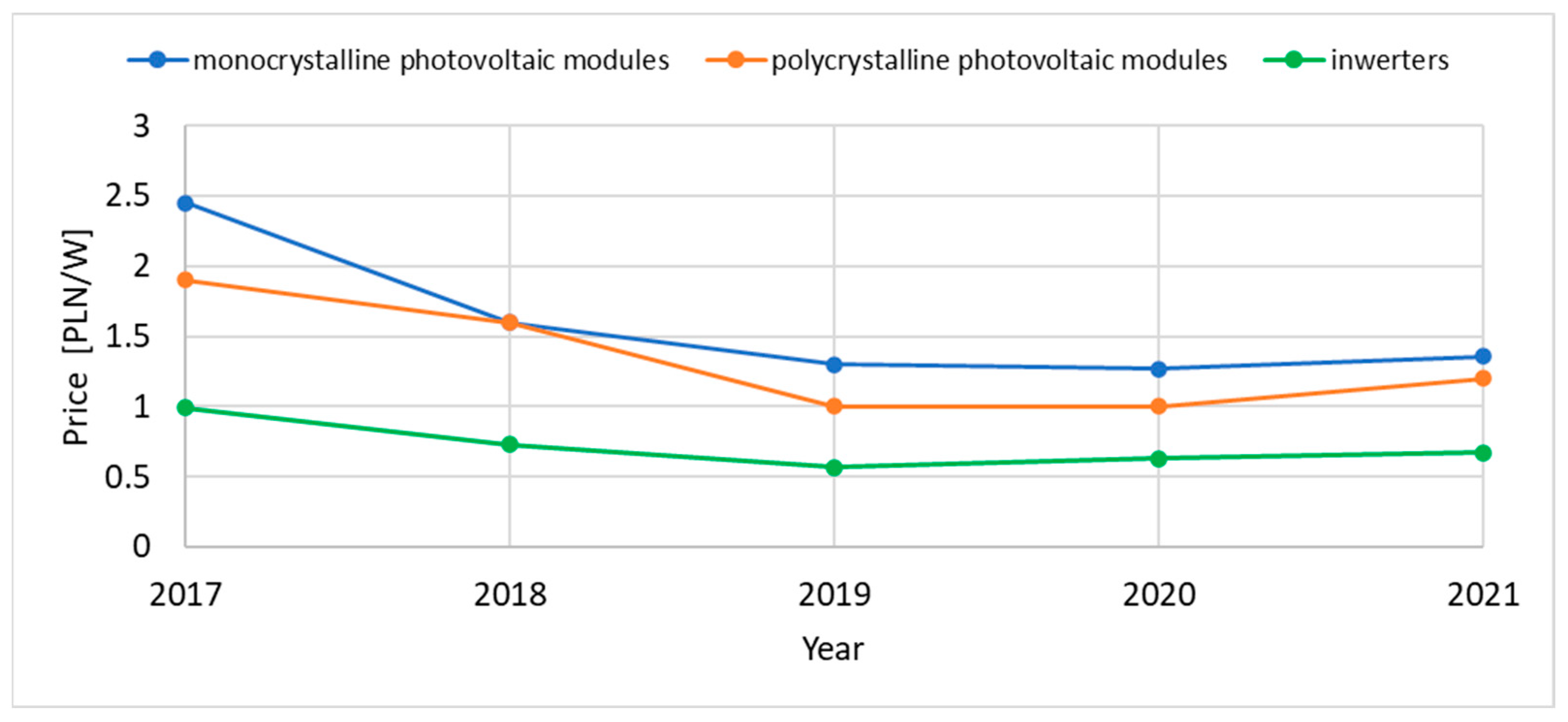

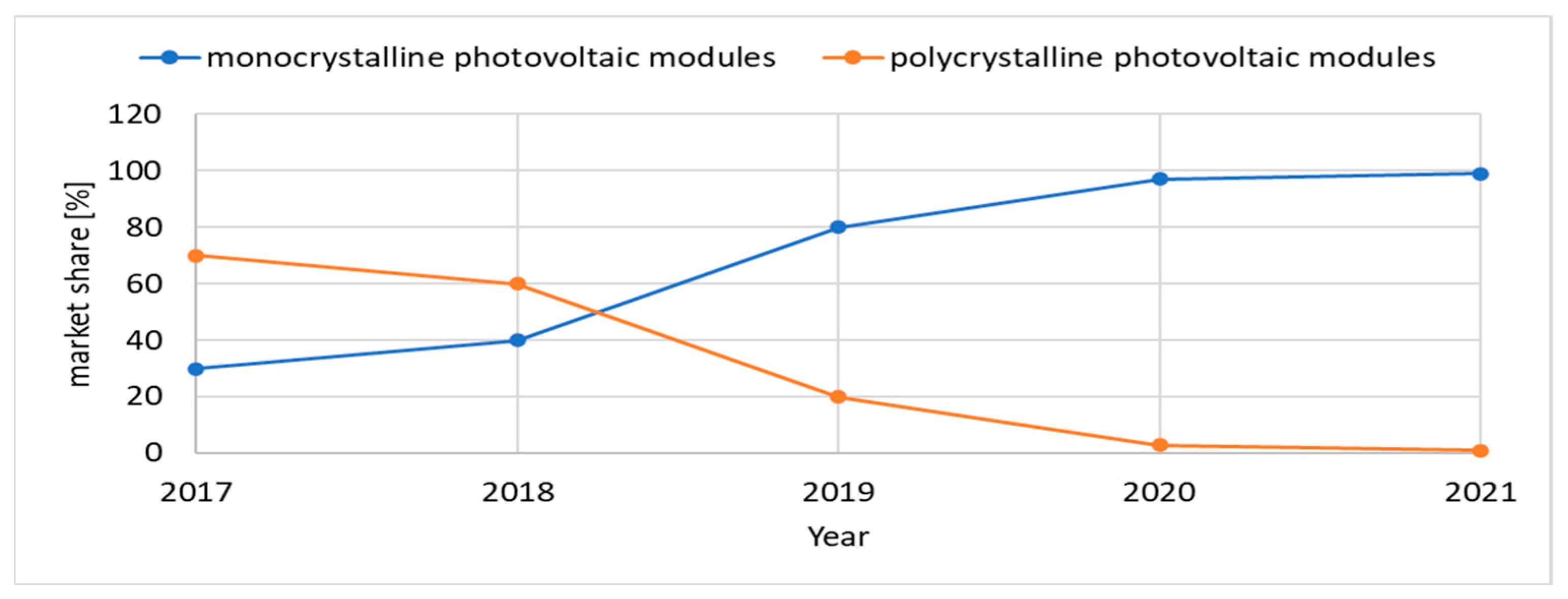
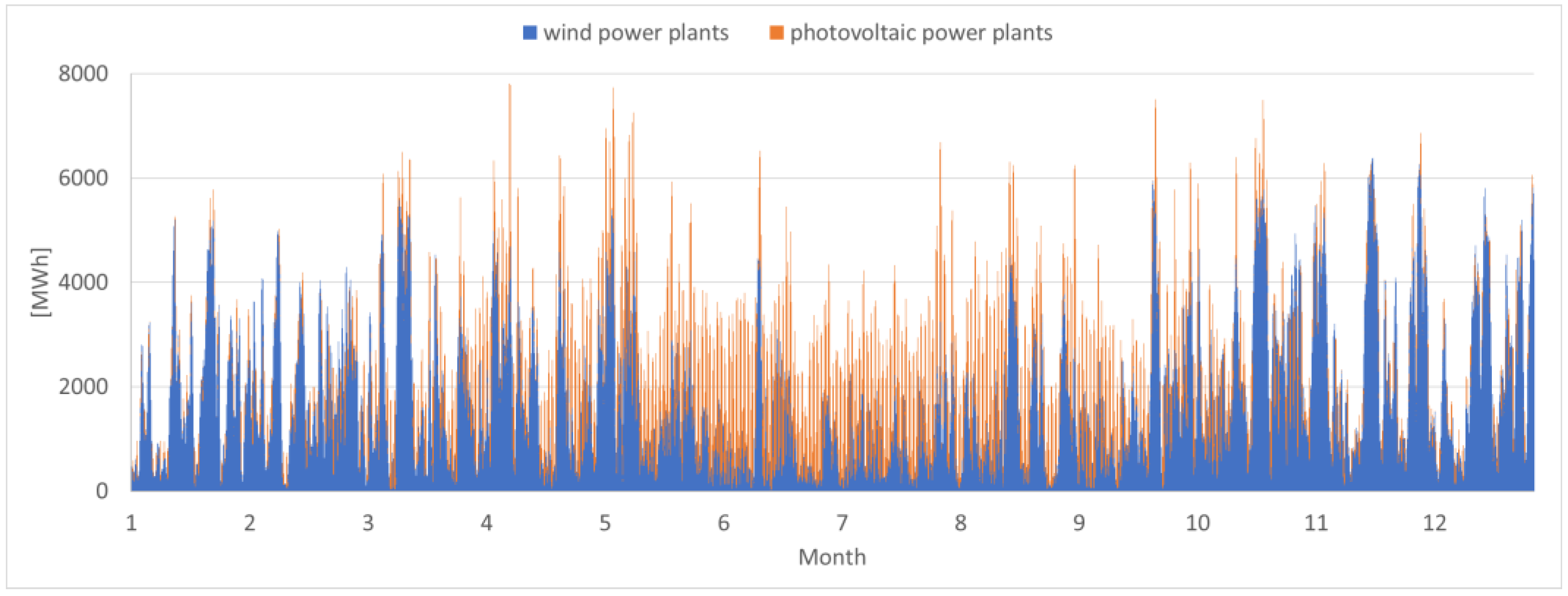
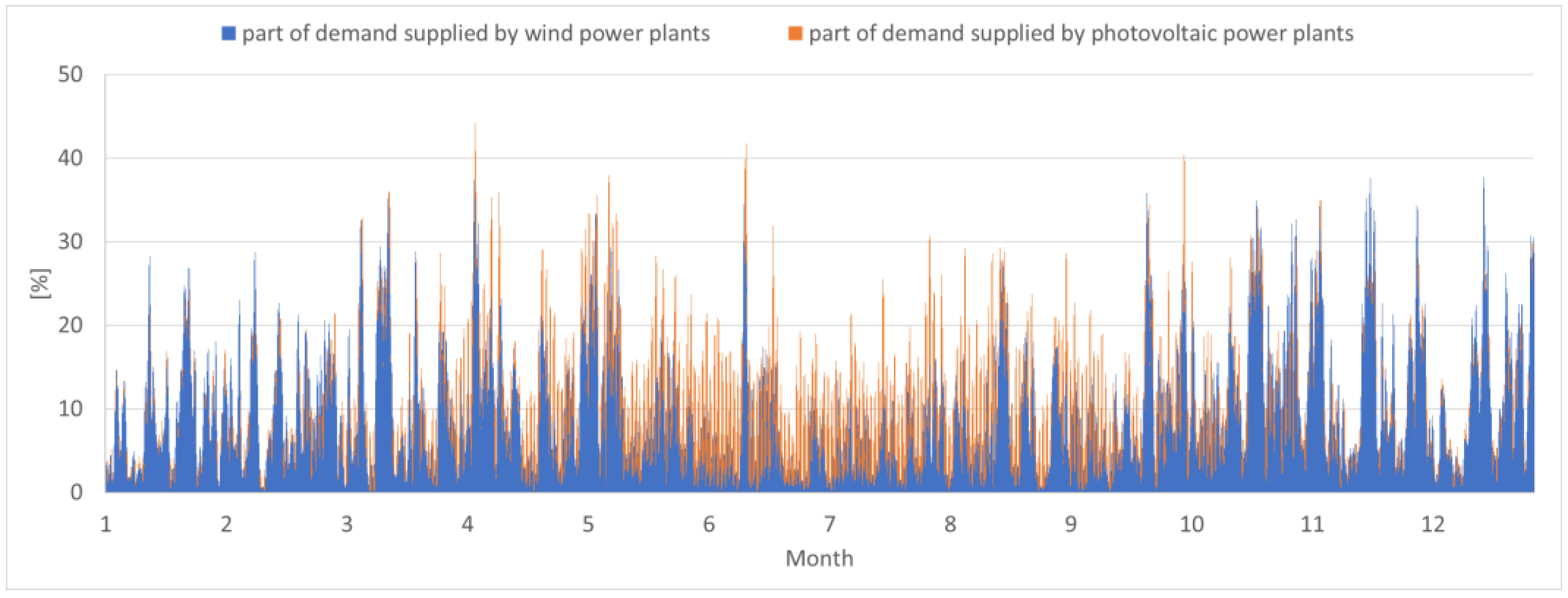
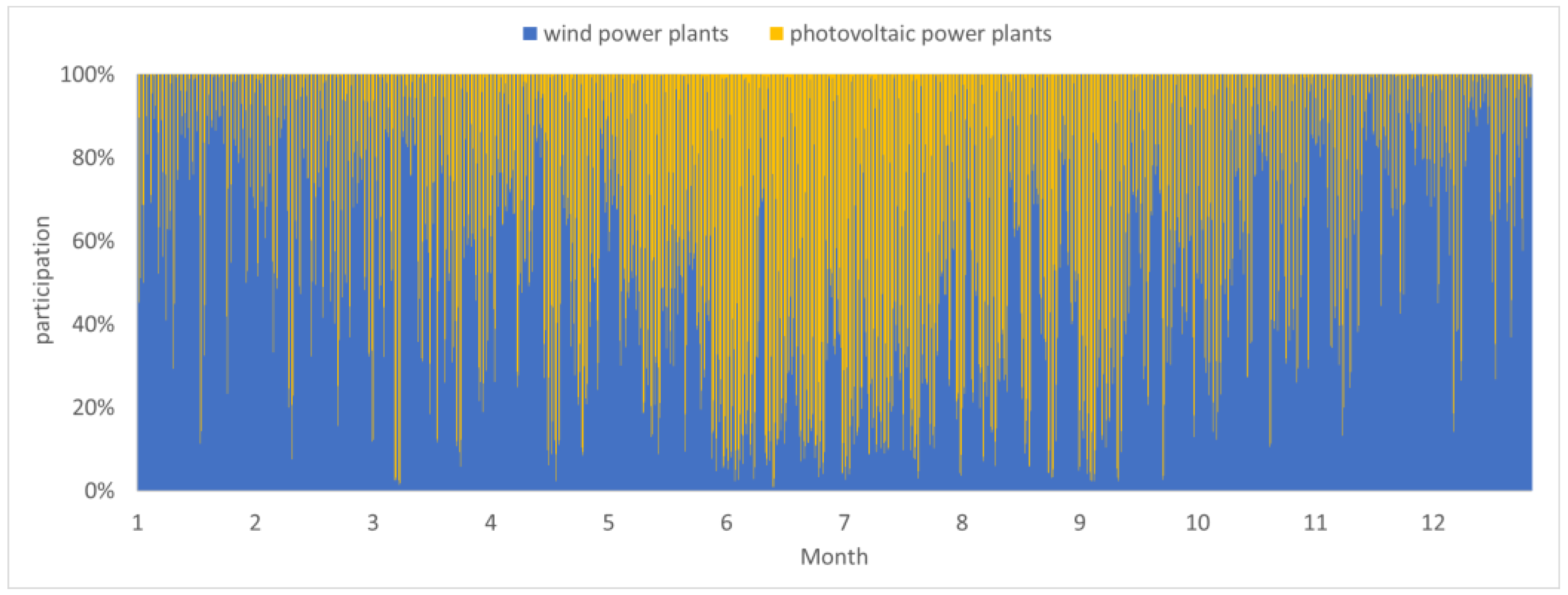
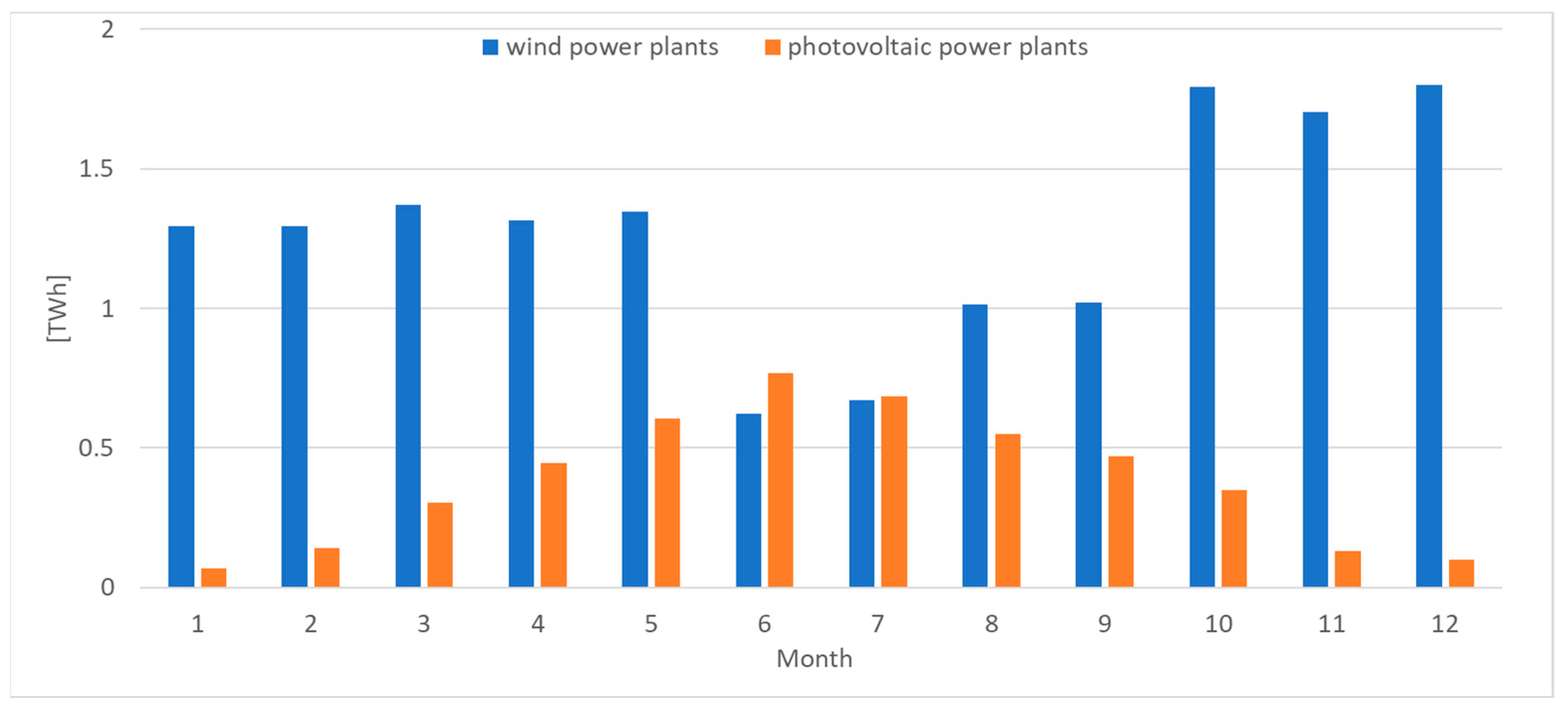

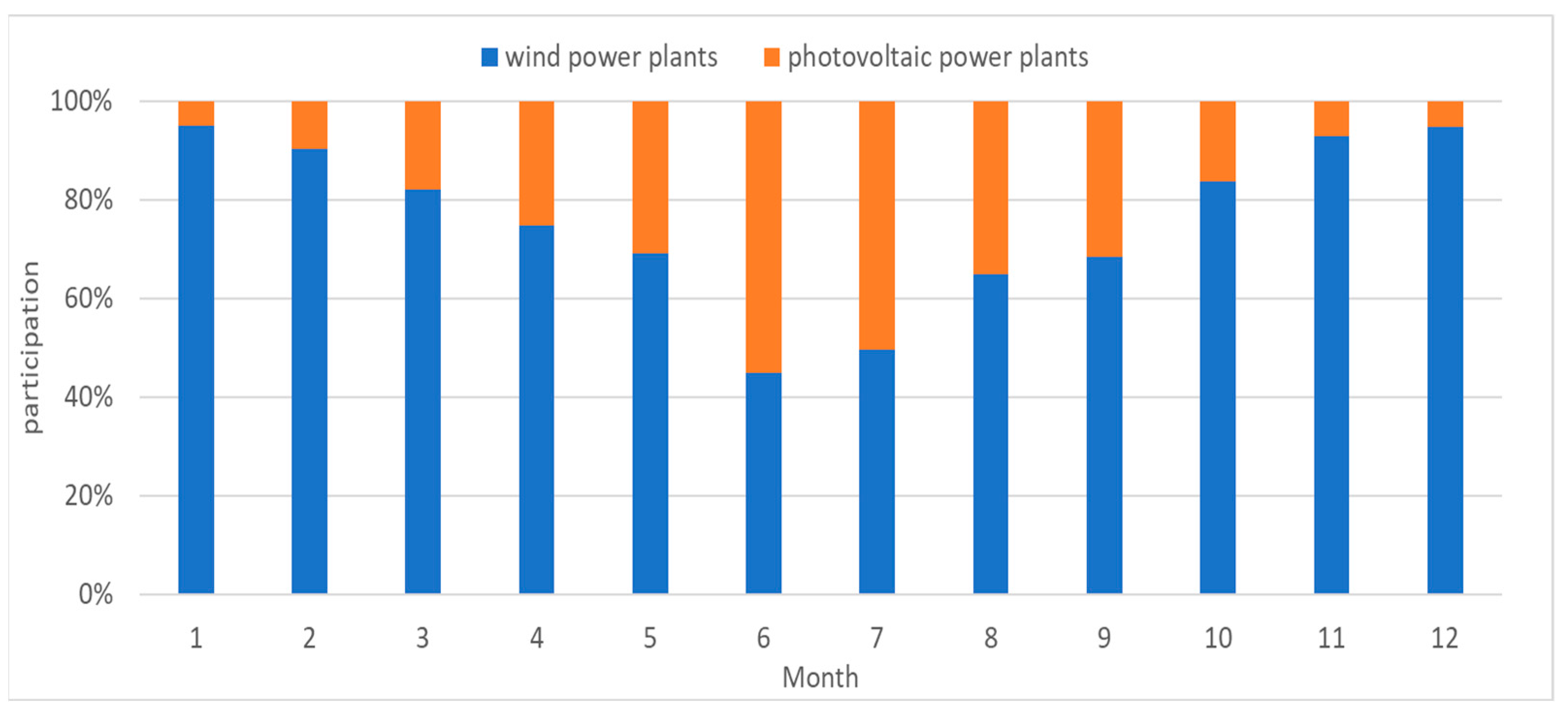
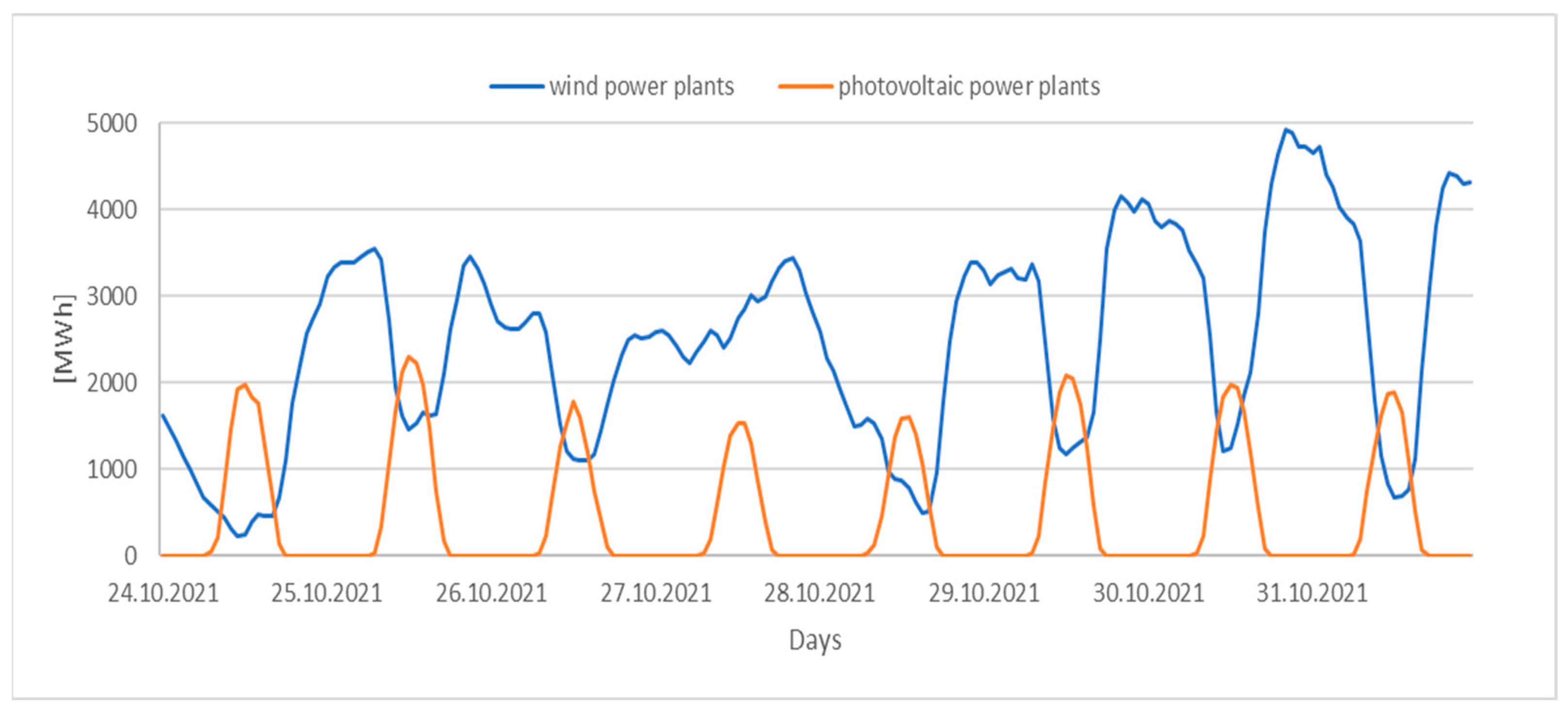

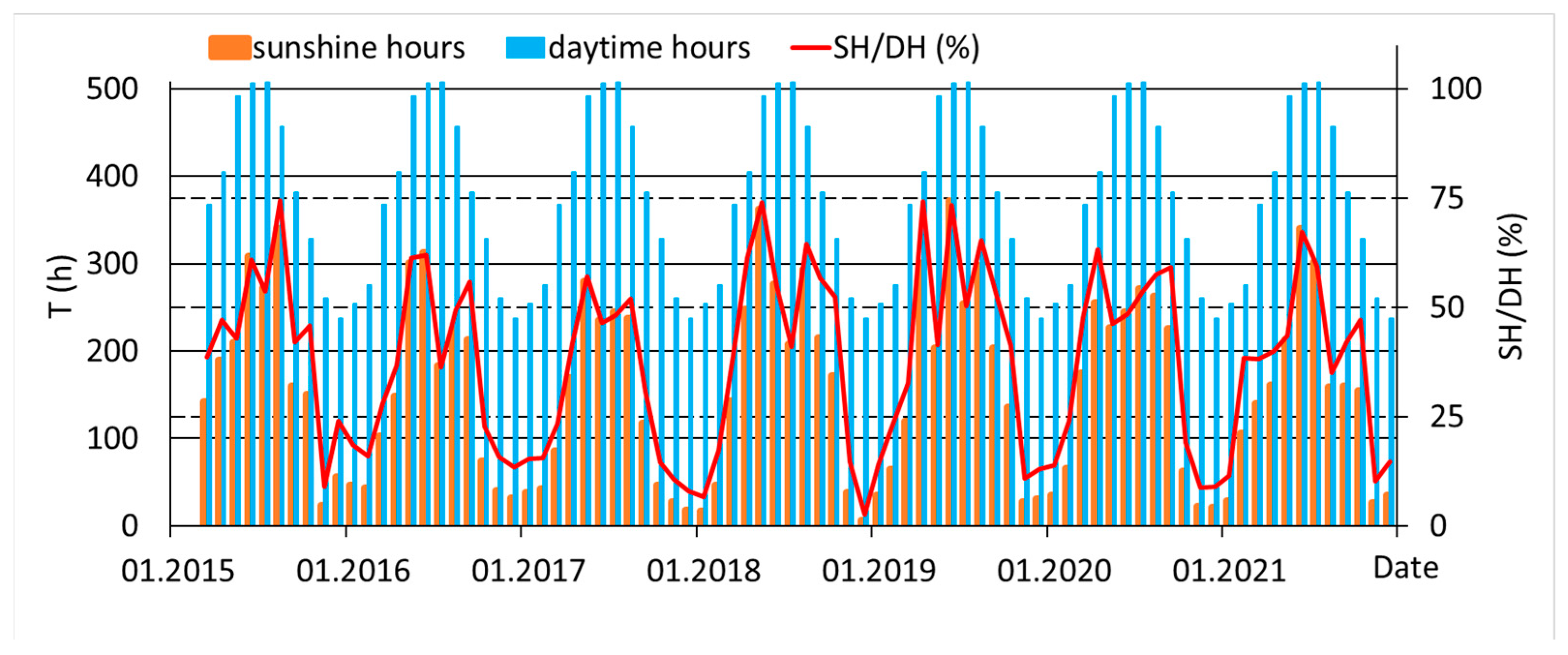
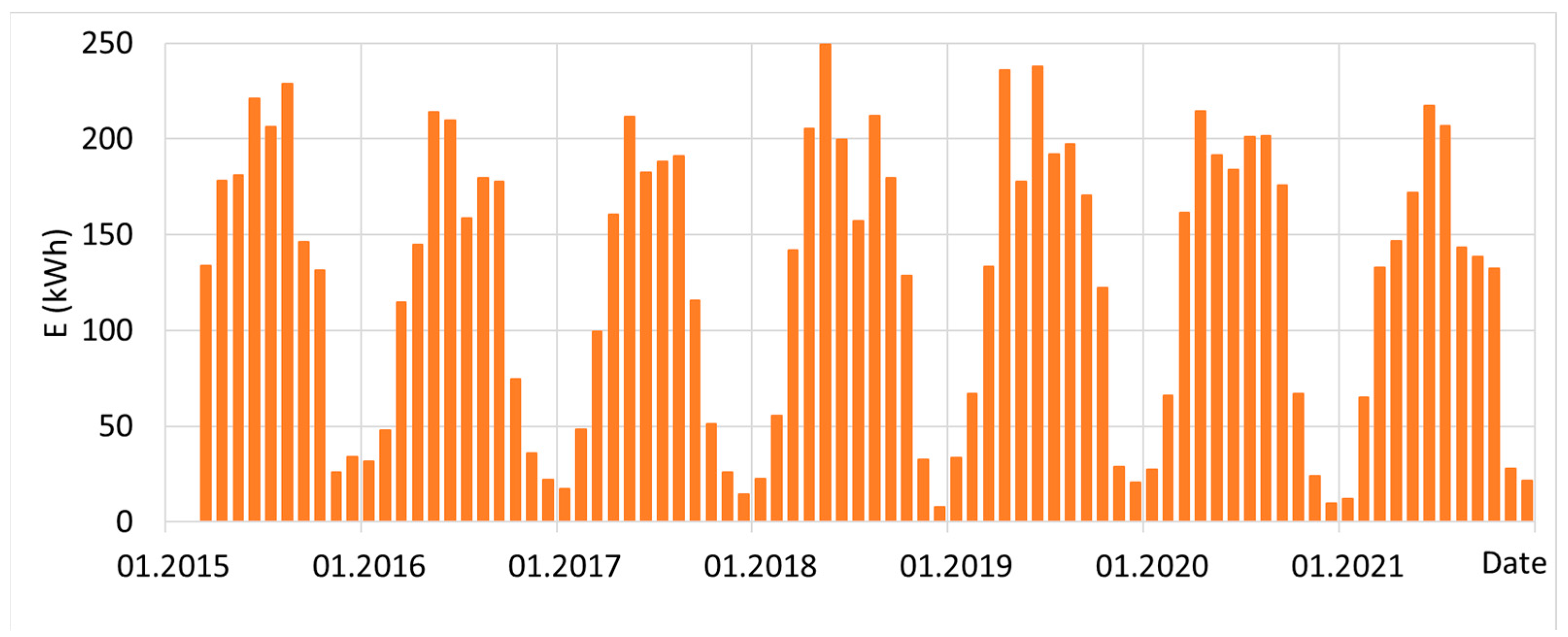

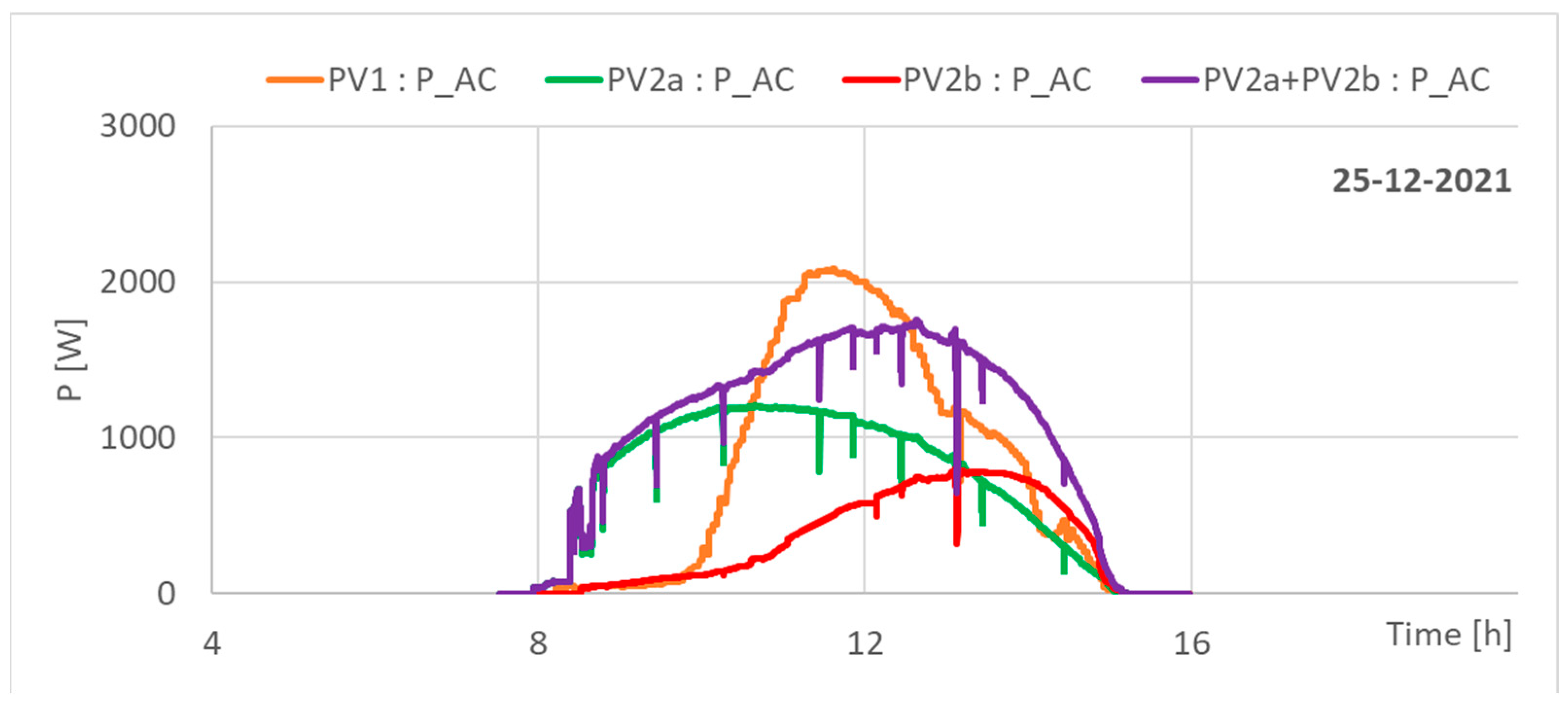
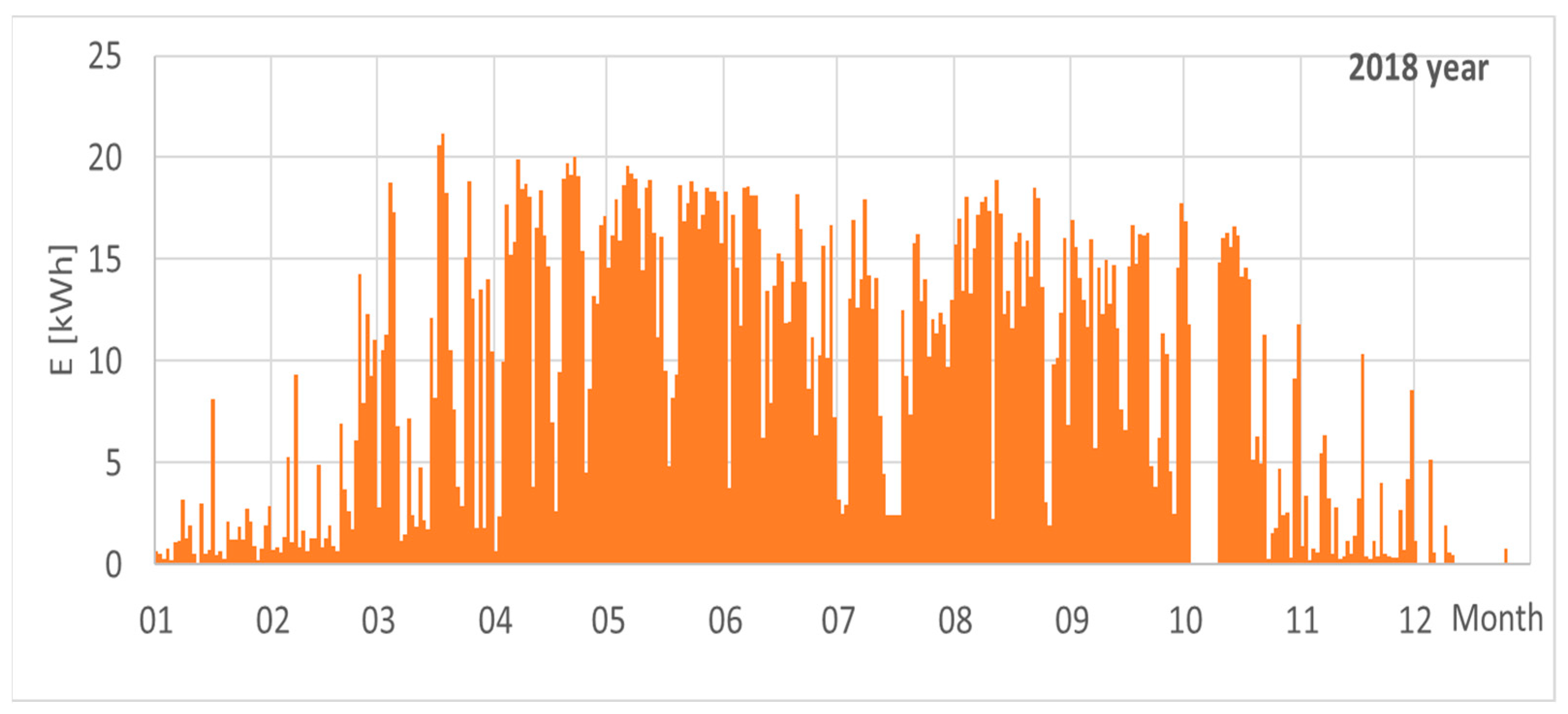
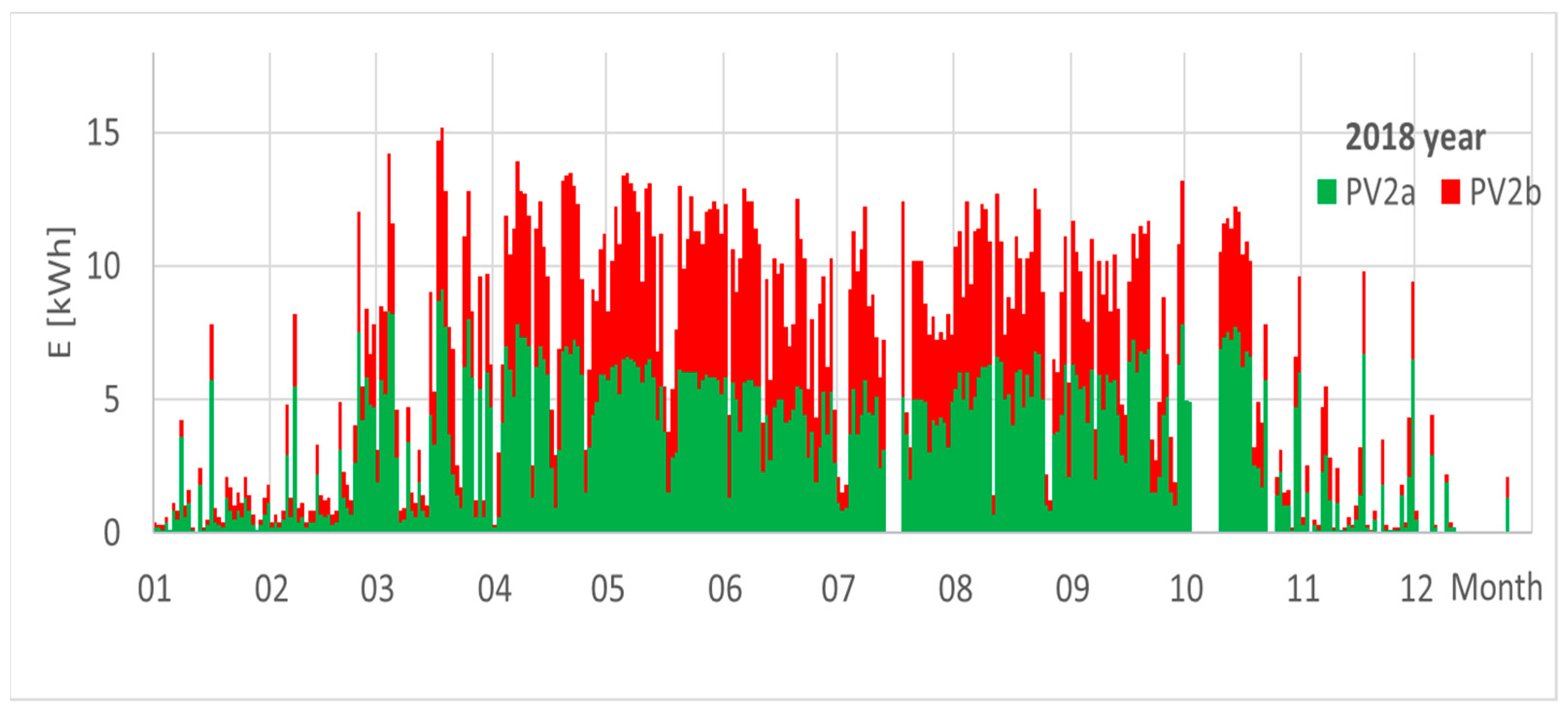
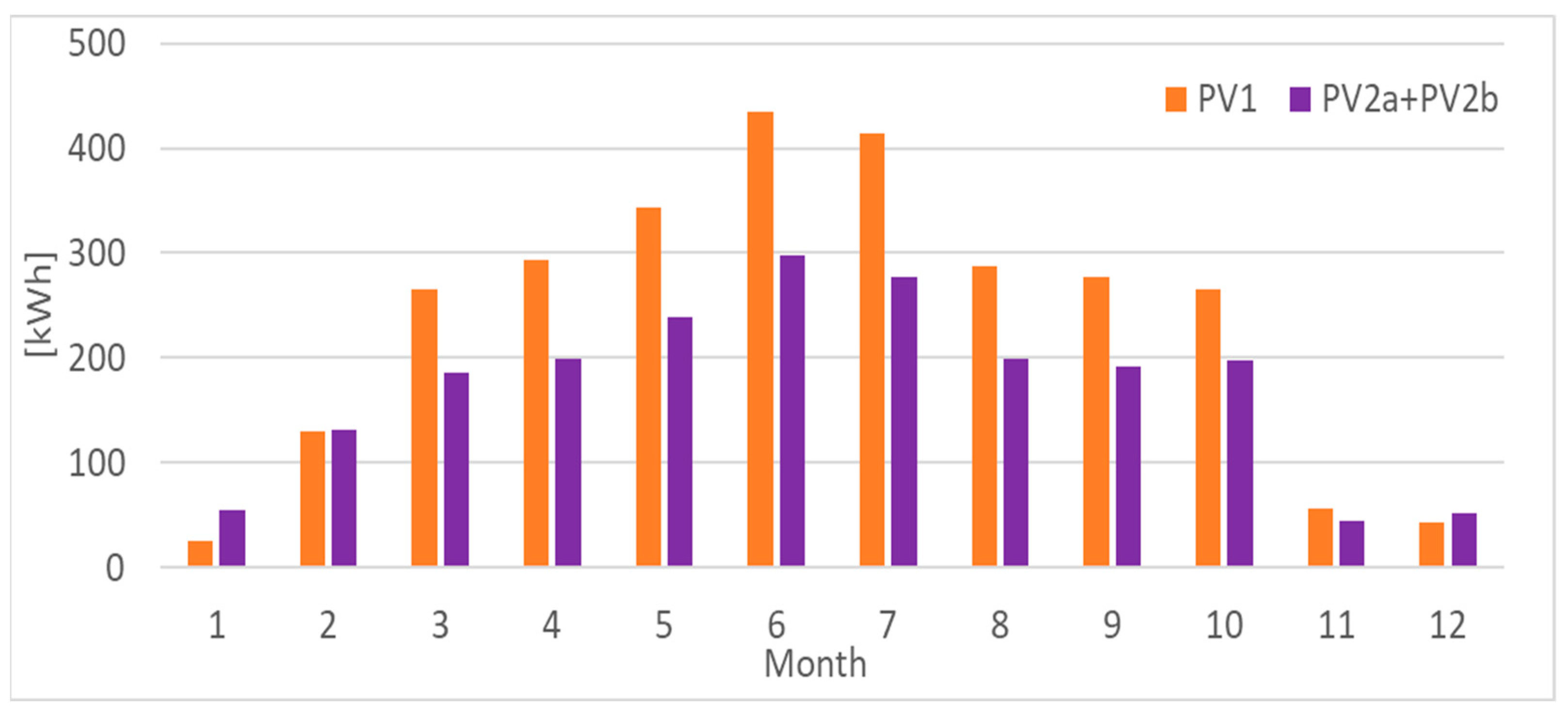

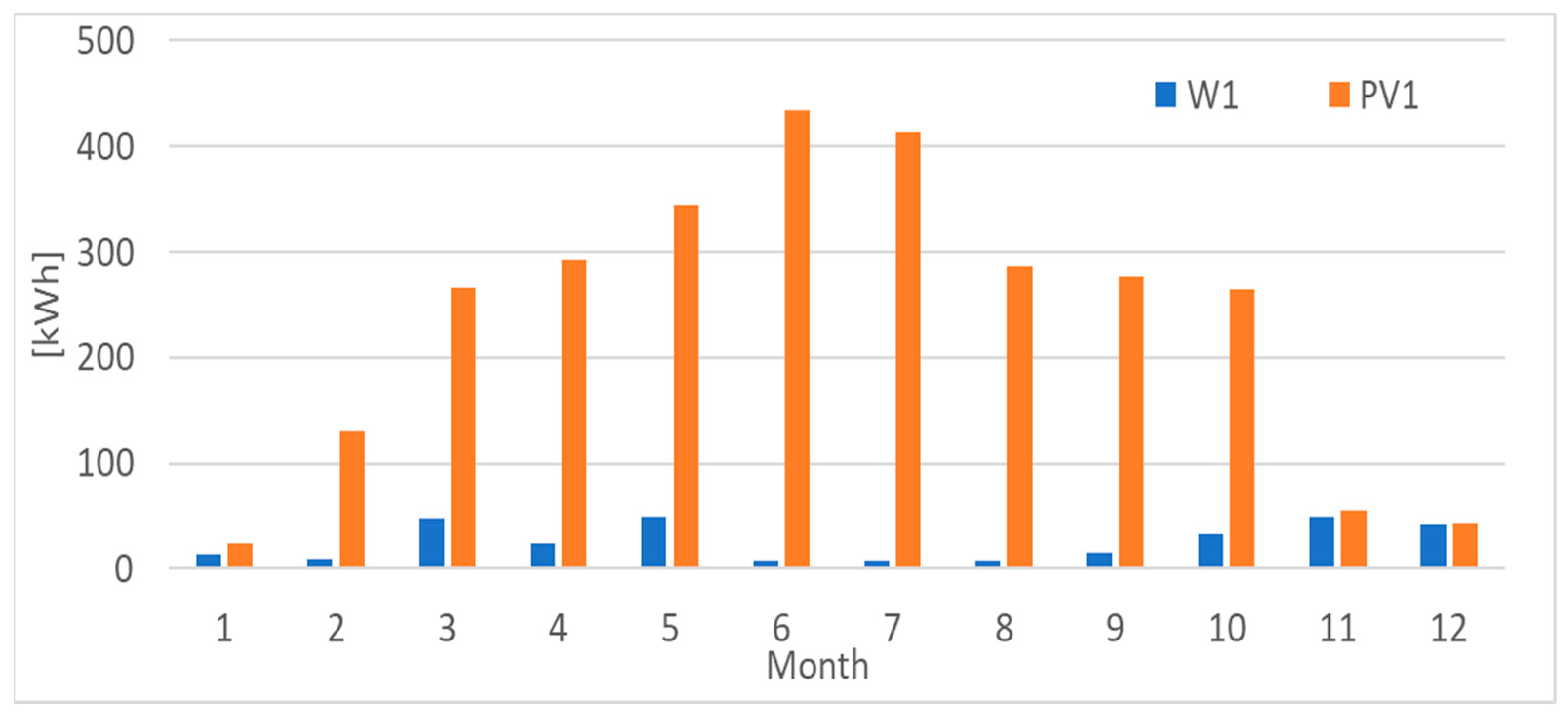
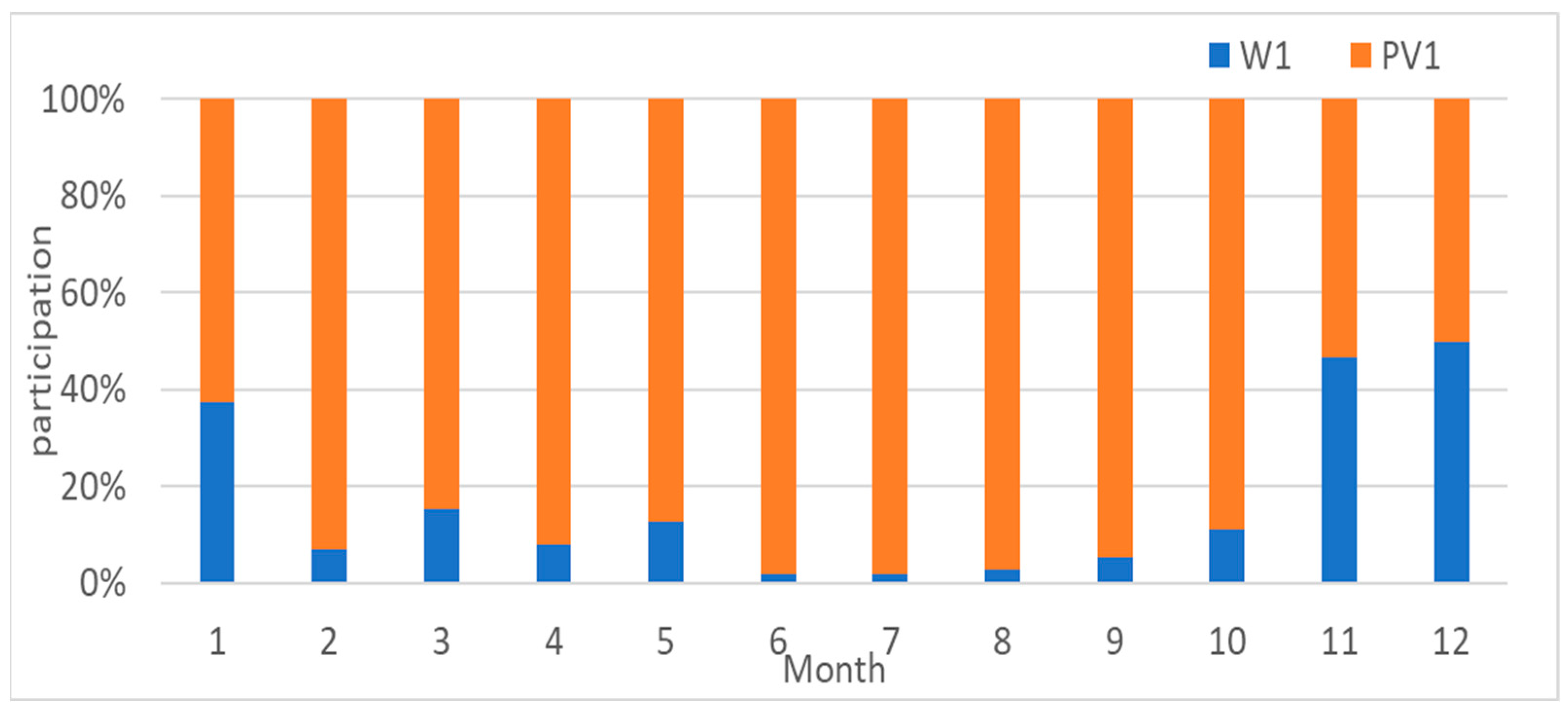
| The Installation Setup | PV1 | PV2a |
|---|---|---|
| Location | On the roof of the building | On the southeastern facade |
| Arrangement | At 38° | At 90° |
| Azimuth | 180° | 160° |
| DC Power | 3.0 kWp | 1.5 kWp |
| Inverter | SMA typ SUNNY BOY 3000 HF, Max. power 3.15 kWp DC [40] | Goodwe NS-1500, Max. power 1.8 kWp DC [41] |
| The number of PV modules | 12 | 6 |
| PV modules type | ESP 250 6P | ESP 250 6P |
| PV3 | PV2b | |
| Location | On the roof of the building | On the southwest facade |
| Arrangement | 0–80° | at 90° |
| Azimuth | 45–315° | 250° |
| DC Power | 3.0 kWp | 1.5 kWp |
| Inverter | SMA typ SUNNY BOY 3000 HF, Max. power 3.15 kWp DC | Goodwe NS-1500, Max. power 1.8 kWp DC |
| The number of PV modules | 12 | 6 |
| PV modules type | ESP 250 6P | ESP 250 6P |
| W1 | W2 | |
| Location | 45A, Wiejska Street, 15-351 Bialystok, Poland On the west side | 45A, Wiejska Street, 15-351 Bialystok, Poland On the west side |
| Power | 5.0 kW | 5.0 kW |
| Inverter | TWERD typ PZGS/5.5kW 400 V AC, 5.50 kW | TWERD typ PZGS/5.5kW 400 V AC, 5.50 kW |
| Turbine | MarkWind 5000P, PHU eChma | POWERwind 5000, H-Darrieus |
| Rotor diameter 4.8 m | diameter 3.5 m, blade height 3 m |
| Symbol | ESP 250 6P |
|---|---|
| Producer | Europe Solar Production |
| Type | Polycrystalline |
| Module Efficiency | 15.3% |
| Peak Power STC | 250 Wp |
| Peak Power NOCT | 182 Wp |
| Temperature Coefficients of Pmax | −0.46 ± 0.02 %/K |
| Temperature Coefficients of VOC | −0.34 ± 0.01 %/K |
| Temperature Coefficients of ISC | +0.07 ± 0.02 %/K |
| Module Dimension | 1640 × 990 × 40 mm |
| 12 years guarantee module performance | Min 90% |
| 25 years guarantee module performance | Min 80% |
Disclaimer/Publisher’s Note: The statements, opinions and data contained in all publications are solely those of the individual author(s) and contributor(s) and not of MDPI and/or the editor(s). MDPI and/or the editor(s) disclaim responsibility for any injury to people or property resulting from any ideas, methods, instructions or products referred to in the content. |
© 2023 by the author. Licensee MDPI, Basel, Switzerland. This article is an open access article distributed under the terms and conditions of the Creative Commons Attribution (CC BY) license (https://creativecommons.org/licenses/by/4.0/).
Share and Cite
Kusznier, J. Influence of Environmental Factors on the Intelligent Management of Photovoltaic and Wind Sections in a Hybrid Power Plant. Energies 2023, 16, 1716. https://doi.org/10.3390/en16041716
Kusznier J. Influence of Environmental Factors on the Intelligent Management of Photovoltaic and Wind Sections in a Hybrid Power Plant. Energies. 2023; 16(4):1716. https://doi.org/10.3390/en16041716
Chicago/Turabian StyleKusznier, Jacek. 2023. "Influence of Environmental Factors on the Intelligent Management of Photovoltaic and Wind Sections in a Hybrid Power Plant" Energies 16, no. 4: 1716. https://doi.org/10.3390/en16041716






